
From Consumer Reports
They say that the best way to predict the future is to create it.
For many auto owners the best is yet to come and the future is so bright that 25 years from now you just may no longer need to pay auto insurance premiums.
Since Henry Hale Bliss became the first known person killed by motor vehicle crash in the United States in 1899 at the corner of West 74th street and Central Park West in New York City, exactly 3,646,407 people have since lost their lives. From 1900-2014 an additional hundreds of millions were injured, resulting in several quadrillions of dollars being spent on auto claims.
In 2014 alone some $132.9B was paid in auto claims by insurance companies, fueling our need to continue to acquire an insurance policy of our vehicles.
For thousands of years mankind had somehow learned to live without car insurance premiums. It was just 116 years ago that the first car insurance policy was sold — in 1898 by Traveler’s Insurance Co. to a Dr. Truman Martin of Buffalo, N.Y., according to the U.S. Census Bureau.
The policy gave Martin $5,000 in liability coverage.
At the time, Martin should likely have been more concerned with crashing into one of the country’s 18 million horses, rather than another of the 4,000 cars in the U.S.
How times have since changed. Over a century later, cars and trucks outnumber horses 237 million to 9 million and only a handful of people still use horses as a means for transportation.
Martin’s 1898 policy only cost him $12.25 annually, which would be about $316.25 today.
As time progressed not only did auto insurance policies become a necessary evil, it became a requirement by law. In 1925 Connecticut, the home of many insurance companies, was first to offer auto liability insurance on a grand scale. Then in 1927, Massachusetts passed the first law making it mandatory to have liability car insurance. Decades later, liability car insurance (or some form thereof) is now required in each of the 50 United States.
Today the average annual cost of car insurance paid in the United States was $907.38 according to a recent study commissioned by Quadrant Information Services. Cost varies greatly by state and in Kentucky that average increases to $1504 annually.
For most families with teenagers, car insurance is the second or third highest bill paid monthly. As for me personally with a family of five, I have to chunk out $473 a monthly, which rounds out to a pricey $5676 a year –serving as proof that even people in the insurance business don’t catch a break.
As a trained safety and risk management professional I believe all accidents are preventable and I have faith in mankind that with the right fortitude and technology we will someday eradicate part of the industry in which I work.
With the most recent technology advancements we have seen in the auto industry, research analysts in the auto insurance market are already predicting the end of the auto insurance business as we currently know it.
They are predicting a society where we evolve from owning and driving cars, to traveling in autonomous self-driving and ride-sharing vehicles to reach point A to point B. They predict that an entire new industry will pop up to provide our transportation needs, making it one of the new emerging disrupting technologies.
A disruptive technology is a new emerging technology that unexpectedly displaces an established one, i.e., auto industry.
As a result this will disrupt how auto insurance will be sold and will help move us to an accident free society and hopefully an auto insurance premium-free society as well.
If it somehow filters down to me in my career, I will worry about a career change at that time.
As we move to a George Jetson society by the 2030’s personal and commercial auto insurance just may be obsolete.
As these new technologies are introduced, accident frequency will start to decline to where the difference among driving behaviors becomes insignificant, making it difficult to charge a significant premium for insurance.
Insurance will take the shape of commercial product liability instead of personal driver liability, as we begin to let robotic autonomous vehicles do all of our driving. Vehicle utilization will increase but the number of vehicles on the road will decline, as one vehicle will serve the driving essential needs of multiple travelers per day, which, will result in fewer vehicles and less traffic problems. Fewer people will own their own vehicles and most will rely on ridesharing and on-demand vehicles for their travel needs.
As this occurs, the risk and premiums will become less about the driver or occupants, and more about the software or particular vehicle –reducing the burden on millions of families that struggle to pay their monthly auto insurance premiums.
All this seems a bit far-fetched I must agree, but I did grow up watching George Jetson. Belonging to a cursed generation that has had to endure a painful lifetime of paying premiums, I just hope that my off-spring will be able to someday reminisce to their grandkids about how they once had to walk to and from school uphill both ways, and how they broke free from the bondage of auto insurance premiums.
Be Safe My Friends.
Keven Moore works in risk management services. He has a bachelor’s degree from University of Kentucky, a master’s from Eastern Kentucky University and 25-plus years of experience in the safety and insurance profession. He lives in Lexington with his family and works out of both the Lexington and Northern Kentucky offices. Keven can be reached at kmoore@roeding.com.
























